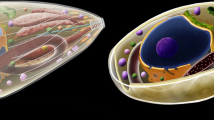Abstract
THE mode of emergence of the infective sporoplasm from Microsporidian spores has baffled protozoologists for many years. According to earlier workers, the sporoplasm creeps out through the aperture from which the filament is extruded. Korke1, Ohshima2, Trager3 and Gibbs4 have described a protoplasmic globule at the tip of the extruded filament of the species studied by them. Ohshima and Gibbs thought that the filament pierces through the tissues, ‘injecting’ the sporoplasm into the host cell; filament extrusion, according to them, being either in a jack-in-the-box manner2 or by eversion like the nematocyst of a cœlenterate4. As Kudo5 has remarked, these views ignore the delicate nature of the filament and the fact that the force required to inject the sporoplasm through a long tubular filament would injure it.
Similar content being viewed by others
References
Korke, V. T., Ind. J. Med. Res., 3, 725 (1916).
Ohshima, K., Annot. Zool. Jap., 11, 235 (1927); Parasit., 29, 220 (1937).
Trager, W., J. Parasit., 23, 226 (1937).
Gibbs, A. J., Parasit., 43, 143 (1953).
Kudo, R. R., Illinois Biol. Monographs, 20, 7 (1944).
Author information
Authors and Affiliations
Rights and permissions
About this article
Cite this article
DISSANAIKE, A. Emergence of the Sporoplasm in Nosema helminthorum . Nature 175, 1002–1003 (1955). https://doi.org/10.1038/1751002a0
Issue Date:
DOI: https://doi.org/10.1038/1751002a0
- Springer Nature Limited
This article is cited by
-
Cloning, Expression and Characterization of Spore Wall Protein 5 (SWP5) of Indian Isolate NIK-1S of Nosema bombycis
The Protein Journal (2022)
-
Eine Mikrosporidie aus dem kleinen Frostspanner (Cheimatobia brumata L.)
Die Naturwissenschaften (1956)





